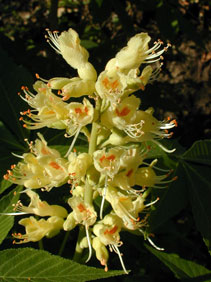WESTERN BUCKEYE
|
 |
| File Size: 81 KB |
|
|
|
Aesculus glabra Willd. var. arguta (Buckl. ) B.L. Robinson
|
| Konza Prairie, Riley County, Kansas |
| Height: 3-12+ feet |
| Family: Hippocastanaceae - Buckeye Family |
| Flowering Period: April, May |
|
| Trunks: | | Erect; bark of young trees smooth, pale yellow-brown; bark of mature trees scaly or flat-ridged, dark brown. | | Twigs: | | Rigid, coarse, reddish-brown or grayish-brown; lenticels conspicuous; terminal bud conical, 2/5 to 1/2 inch long, reddish-brown. | | Leaves: | | Opposite, deciduous, palmately compound, stalk 4 to 6.5 inches long, enlarged at base; leaflets 5-11, usually 7, elliptic, lanceolate or egg-shaped, 3 to 6 inches long, .6 to 2.4 inches wide; upper surface glabrous, shiny, dark green; lower surface paler, pubescent on veins to minutely hairy or woolly; margins entire at base, sharply toothed above; tip sharp-pointed or tapering to narrow point; leaflet stalks to 2/5 inch long. The number, shape and size of the leaflets can be quite variable. | | Flowers: | | In panicle, cylindrical or pyramidal, 4 to 6 inches long, terminating main branches. Calyx broadly bell-shaped, 1/8 to 1/3 inch long, yellowish-green, 5-lobed; lobes, unequal, blunt, pink-tipped; corolla 2/5 to 7/10 inch long; petals 4, pale yellow, outside hairy; upper 2 petals erect or curved, with 2 orange spots inside; 2 lateral petals slightly shorter, with orange streak inside; stamens 7, curved, 1/2 to 4/5 inch long, extending beyond corolla; filaments hairy near orange anthers; style greenish, stigma red. | | Fruit: | | Unevenly spherical, 1 to 2 inches in diameter, rust-colored; husk leathery, spiny, divided into 3-4 sections; seeds 1-4, irregularly spherical, nut-like, about 1 inch in diameter, smooth, glossy, dark brown with large, pale scar. | | Habitat: | | Stream banks, rocky wooded hillsides, lowland woods, and thickets in prairie ravines; moist, often calcareous soil. | | Distribution: | | East 1/2 of Kansas. | | Origin: | | Native | | Toxicity: | | The seeds are mildly poisonous with swine particularly susceptible. The leaves are poisonous to livestock. Clinical signs include staggering, trembling and legs splayed out like a sawhorse. These symptoms typically last 24 hours. | | Uses: | | Native Americans ate the seeds after boiling or roasting. The seeds were ground and thrown into streams to poison the fish. There was also a superstition that carrying a seed in pocket would alleviate rheumatism. |
|
| Western buckeye inflorescence |  | | 99 KB | | Konza Prairie, Riley County, Kansas |
| | Western buckeye |  | | 104 KB | | Konza Prairie, Riley County, Kansas |
| | Western buckeye |  | | 80 KB | | Konza Prairie, Riley County, Kansas |
| | Western buckeye flowers |  | | 64 KB | | Konza Prairie, Riley County, Kansas |
| | Western buckeye leaf |  | | 103 KB | | Konza Prairie, Riley County, Kansas |
| | Buckeye |  | | 82 KB | | Konza Prairie, Riley County, Kansas |
| | Buckeye |  | | 70 KB | | Jefferson County, Kansas |
| | Buckeye bark |  | | 135 KB | | Jefferson County, Kansas |
| | Buckeye buds |  | | 41 KB | | Konza Prairie, Riley County, Kansas |
| | Western buckeye fruit |  | | 84 KB | | Geary County, Kansas |
| | Western buckeye buds |  | | 131 KB | | Clay County, Kansas |
| | | | |
|
|
|